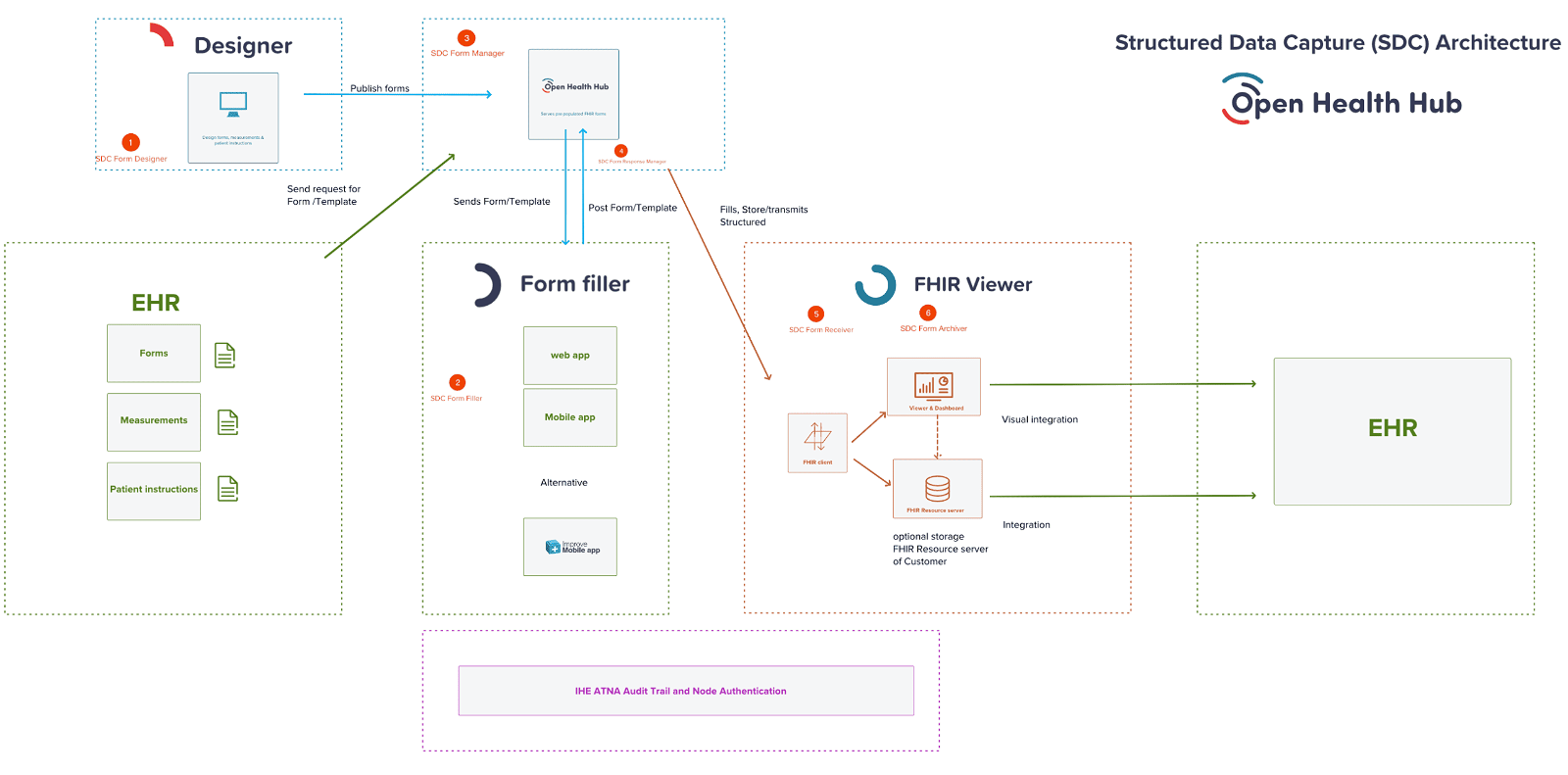IHE Structured Data Capture for medical forms
Streamlining healthcare data capture with IHE Structured Data Capture and FHIR
In this blog, our CTO describes how IHE and FHIR SDC standards revolutionize medical form management. This approach accelerates the digitalization of the healthcare processes in a sustainable way using standard FHIR APIs and SDKs.

Streamlining healthcare data capture with IHE Structured Data Capture and FHIR
In this blog, our CTO describes how IHE and FHIR SDC standards revolutionize medical form management. This approach accelerates the digitalization of the healthcare processes in a sustainable way using standard FHIR APIs and SDKs.
In my daily work as CTO of Open Health Hub I often deal with medical forms and questionnaires. When talking to people in the healthcare industry, but also privately with my family and friends, I often get the question what the excitement around a medical form or questionnaire is. A medical form on its own, whether it’s digital or on paper, is certainly not very exciting. Yes, they take time to fill in and when you go for treatment different health professionals often ask you to fill out the same forms or ask you the same questions.
In essence, a medical form is not very exciting. But it becomes exciting when you have to fit a medical form into the core process of a healthcare organisation and deliver a form to the right place at the right time, enrich it and capture it so that it can be used by healthcare professionals. Enrichment and capturing structured data is also required to train AI applications used by healthcare providers.
There is a lot of enterprise technology required to do this orchestration correctly and securely. To scale this process, we at Open Health Hub have based our enterprise solution on the international standards IHE and FHIR. In particular, the IHE Structured Data Capture profile and the FHIR SDC specification allow us to use microservices in our architecture. This helps our customers to achieve their goal of efficient digital communication by delivering a medical form at the right time, enriching the data and getting it to the healthcare professional speedily, while reducing the administrative overhead.
Let me explain a little more about the IHE SDC components and roles.
IHE Structured Data Capture
The IHE SDC is a set of standards and guidelines designed to improve the capture of structured data in healthcare. It provides a common framework for exchanging structured data between different systems and applications, including electronic health records (EHRs), patient portals and clinical research systems.
FHIR SDC (Fast Healthcare Interoperability Resources Structured Data Capture) is a specific implementation of structured data capture using the FHIR standard. FHIR is a modern, flexible and modular standard for healthcare information exchange that is designed to be easy to use and implement. The FHIR SDC standard enables the capture and exchange of structured data using FHIR resources such as questionnaires, questionnaire responses and care plans.
IHE SDC roles & actors
The IHE Structured Data Capture (SDC) profile identifies a number of roles and actors involved in the capture and exchange of structured health information. At Open Health Hub, we use our microservices enterprise architecture to fulfil these roles and actors.
- SDC Form Designer: This role is responsible for designing and implementing questionnaires, forms and patient information. For example, with our Design solution, you can use our own catalogue of over 400 ready-to-use questionnaires, PROMs, etc. to develop your own forms easily and fast. In the Designer, coding systems can be added to questionnaires and responses, such as EHR, SNOMED CT, eCRF. The designer can publish the questionnaire on the Open Health Hub.
- SDC Form Filler: This role is responsible for filling in the forms designed by the SDC Form Designer. Open Health Hub provides an SDK/APIs for third party SDC Form Fillers, Embedded Form Filler SaaS application for linking and embedding into other systems, such as patient portals. We also provide a standalone Mobile App. The applications are multilingual and all data is encrypted end-to-end.
- SDC Forms Manager: This role is responsible for managing forms per organisation or region. Forms can be pre-populated using the FHIR CarePlan profile and forms can be assigned per organisation, organisational unit, care team or practitioner. The Form Manager is API driven with a web application for SSO rights management for individuals or FHIR clients.
- SDC Form Response: This role is responsible for the use of FHIR Plan Definition and FHIR Questionnaire Response completed forms. FHIR subscriptions notify the SDC Form Receiver when a form is completed.
- SDC Form Receiver: This role is responsible for receiving and processing data to one or more SDC Form Archivers. The local Open Health Hub FHIR client receives the data, decrypts and automatically processes it using pull & push methods (based on the FHIR subscription).
- SDC Form Archiver: This role is responsible for archiving the data in the healthcare organisation’s EHR, EDC or data lake. The SDC Form Archiver integrates with the Open HealthHub SDC Form Receiver. As SDC Form Archiver, we provide a FHIR viewer that can be visually integrated into the EHR.
The benefits of IHE Structured Data Capture
The main benefits of Structured Data Capture are seamless orchestration of the medical forms process for all stakeholders. This accelerates the digitalization of the healthcare processes in a sustainable way using standard FHIR APIs and SDKs.
Using SDC as the architectural principle for the Open Health Hub, we can ensure that medical forms are delivered to the right place at the right time and can be enriched to reduce the administrative burden on healthcare professionals. And that knowledge makes working at the Open Health Hub so rewarding and exciting every day.


+31 85 333 00 07
info@openhealthhub.com
@openhealthhub
linkedin.com/company/openhealthhub